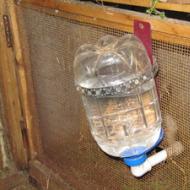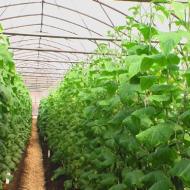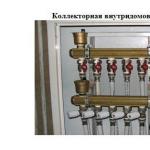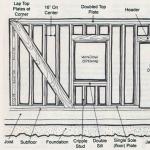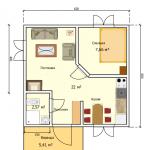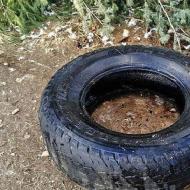
Do-it-yourself drinking bowl for chickens - photos, videos, diagrams and drawings. Water doesn't freeze
Many chicken breeders at the initial stage are faced with the issue of arranging the territory of the chicken coop. Feeders and drinkers for chickens do not have to be purchased at the store; you can make them yourself from scrap materials. A drinking bowl for chickens can be made from a sewer pipe or unnecessary plastic bottles. To do this, you need to study in advance types of sippy cups and features of their design for ease of use by birds.
Chickens are not clean birds, so they can easily clog their own watering hole. If you put water in a regular jar for them, then after a while you can see grain and droppings there. Chickens constantly get into the water not only with their dirty beaks, but also with their paws.
But it is no secret for any owner that only clean water is an indicator of health. For this purpose it is better choose these options, at which the water can maintain transparency. Today there are four types of drinkers that you can make yourself:
- The simplest option, often used in farming, is a regular bucket or bowl of water. This option is chosen by lazy farmers who do not particularly care about their birds.
- Another equally common option that you can make at home for your own chicken coop with your own hands is a vacuum drinker.
- If a farmer values the health of his birds and the quality of his products, then he will certainly give preference to the nipple type, which combines quality, reliability and efficiency.
- You can make a drinking bowl with your own hands from a polypropylene pipe, a piece of which may have been left over after a bathroom renovation.
What are the requirements for drinking bowls?
To make a drinking bowl for chickens with your own hands from scrap materials, you need to know what requirements it must satisfy. We can highlight the main criteria that they must meet:

Drinkers for chickens: how to make from scrap materials
If there are not enough funds to purchase required number of drinkers in the store, you can use your own knowledge and hands to make them yourself.
A do-it-yourself vacuum drinker for chickens is made from a can or plastic bottle using another container in the form of a bowl of a larger diameter. For this purpose, you can use plastic water bottles with a volume of 1.5 - 2 liters and 5 liters. A five-liter bottle is cut around the circumference at a distance of 17 centimeters from the edge of the cap.
Thus, it turns out to be a bowl for water or drinking bowl. Next, you need to secure the cap from a two-liter bottle in the cap from a five-liter bottle using a screw. In this case, the threads of both covers should be directed in the same direction.
Then a small hole is made in a two-liter bottle, about 8 millimeters in diameter from the bottom edge, less than 15 centimeters from the cap. Then the bottle should be filled with water and secured near the wall using wire or any other available material.
DIY bird drinker made of polypropylene pipe
 The length of such a drinking bowl depends on the number of birds. The more there are, the longer the pipe should be. They do it in a pipe oblong holes at a distance of 30 centimeters from one another. One edge of such a drinking bowl is closed with a plug, and the other is connected to a container of water or a water supply system. Water enters the drinking bowl from the pipe through a drain valve or tap. The pipe drinking bowl is attached to the wall of the chicken coop with clamps of the required diameter.
The length of such a drinking bowl depends on the number of birds. The more there are, the longer the pipe should be. They do it in a pipe oblong holes at a distance of 30 centimeters from one another. One edge of such a drinking bowl is closed with a plug, and the other is connected to a container of water or a water supply system. Water enters the drinking bowl from the pipe through a drain valve or tap. The pipe drinking bowl is attached to the wall of the chicken coop with clamps of the required diameter.
Nipple bird drinkers
Compared to the above-mentioned drinker options, a nipple drinker may seem like a rather difficult option to make on your own. This device is actually very easy to make.
The simplest and most affordable model The nipple drinker is made from a plastic bucket or bottle. The bucket must have a lid. At the bottom of the bucket you need to make holes for attaching nipples. After completing the nipple work, it must be hung in the chicken coop at the required height.
For young animals, 3600 nipples are used, which are capable of supplying water in all directions. For adult birds, nipples can be purchased for 1800, but they will work on an up-down principle. Install them from each other at a distance of 20 centimeters. You can purchase them at any specialty store or through an online store.
To make holes you will need a 9 mm diameter drill bit and a drill. To prevent the drinker from leaking, you must use Teflon tape to wrap the nipples. Such a drinking bowl made from a pipe or bucket, can later be connected to a water supply or water tank.
The nipple itself looks like a stainless metal rod with a valve in a plastic case. The chicken, wanting to drink water, approaches the drinking bowl and presses the stem with its beak, receiving the required amount of water from the drinking bowl. This creates a birdbath that is easy to make and effective to use.
It should be noted that chickens do not need to be specially trained to do this. Birds' natural instincts kick in when they detect drops of water on their nipples. Among the obvious advantages of such a system are:
- Ease of use.
- Stability of the system against capsizing.
- Constant purity of drinking water.
- Dosed water supply.
How to make a nipple drinker for birds with your own hands
 To make this necessary household device yourself, you need to make blanks from three pieces of pipe. From the first two segments there will be the drinking bowl itself was made, in which the nipples are located. They are located horizontally. The section of pipe that will serve as a tank in the drinker is installed vertically.
To make this necessary household device yourself, you need to make blanks from three pieces of pipe. From the first two segments there will be the drinking bowl itself was made, in which the nipples are located. They are located horizontally. The section of pipe that will serve as a tank in the drinker is installed vertically.
Using a drill and a drill, holes are drilled in the first sections of the pipe for installing nipples. Using a tap, make a thread and blow out the holes so that no metal shavings remain in them.
The holes are sealed with Teflon thread and the nipples are inserted. Then the plugs are installed. When connecting pipes through adapters, use Teflon thread to ensure the tightness of the product.
Drip drinker for chickens
Unlike the above nipple drinker, the drip model of the sippy cup is distinguished by cups installed under the nipples for collecting water. In such drinking bowls, birds can drink not only from nipples, but also from cups in which water will collect after drinking.
You can make such a sippy cup either yourself using improvised materials in the form of buckets and cut-off parts from plastic bottles, or you can opt for factory-made plastic products. You can make a drip drinker by analogy with a nipple drinker, but by installing a drip catcher on it.
In advance to the owner of the farmstead you should decide on the drinking bowl model and its length. A regular vacuum chicken drinker is enough for about 7 – 10 birds. For this purpose, pipes of the appropriate length should be purchased in advance.
Materials needed to assemble the nipple drinker
To assemble a nipple or drip drinking system you need to purchase:

Tips for arranging drinking bowls for chickens in the cold season
 Heated drinking bowls for chickens especially relevant during cold periods. When the thermometer needle drops to sub-zero temperatures, the water in the drinkers begins to freeze, and the birds risk being left without something to drink.
Heated drinking bowls for chickens especially relevant during cold periods. When the thermometer needle drops to sub-zero temperatures, the water in the drinkers begins to freeze, and the birds risk being left without something to drink.
If the barn can be connected to an electrical supply, you can make your own heated waterers to provide fresh water for the birds.
To prevent the water from freezing, you need to build a metal box, inside which you will need to install a simple incandescent light bulb. A small hole is left in the upper part of the box and a drinking bowl is placed on top of it. The water in the drinking bowl does not freeze thanks to the incoming heat from the lamp.
If it is not possible build a metal box, then you can place the lamp inside a foam block or cinder block. A tin box of cookies or sweets is also suitable.
Instead of a light bulb, you can use a cable to heat the sippy cups, which is usually used when installing heated floors. This cable is sold by the meter in specialized stores. The container of the nipple drinker can be wrapped in a circle, the wires can be insulated and connected to the network.
If such a system is supplemented with a special unit for regulating the switching on and off of the power supply, then it is possible to provide the drinking cup with automatic heating. This way, the birds will always have water at the right temperature.
A less expensive option for a winter sippy cup for domestic livestock this option can be considered. The sippy cup is placed in a container of larger diameter and the entire space between them is filled with foam.
Attention, TODAY only!
Now more and more people at their dachas are raising poultry with their own hands. This trend is easily explained by several factors. The first and main thing is environmental friendliness. You know exactly where your chickens were raised and what you fed them. Therefore, the risk of eating low-quality meat is reduced to zero.
Organizing a chicken coop with your own hands at your dacha allows you to eat fresh eggs every morning. Every farmer knows that they taste completely different from store-bought ones.
Moreover, do not forget about the possibility of sale. Keepers of large chicken coops always sell meat and eggs to neighbors, and they are happy to buy them because they know where the products were grown and under what conditions.

However, in order to get a high-quality final product and at the same time minimize your participation in all processes in the chicken coop, you need to organize everything correctly. One of the most important elements in this structure is the chicken drinker.
Important ! You don’t have to buy a drinking bowl for chickens - you can make it yourself.
To create a drinking bowl for chickens with your own hands, you can use things available at every dacha. Although for some designs you will have to purchase several items that will allow you to quickly and efficiently provide the bird with water.
How should drinking bowls be used for chickens?
Requirements

You need to start creating a drinking bowl for chickens with your own hands by studying the requirements for this design. It is worth recognizing that chickens are very sloppy birds. If everything is not arranged securely, the chicken may jump into the drinker or even turn it over.
Attention ! Chickens should consume only fresh, clean water - this is the key to their health.
When calculating the amount of water that chickens should consume, a number of factors are taken into account, including:
- ambient temperature,
- feed consumed by chickens,
- air temperature.
If we take average indicators, then each chicken should drink about one and a half liters of water per day. Otherwise, the chickens may become dehydrated.

To make it comfortable for chickens to drink water from a drinking bowl made by you, the design must meet the following parameters:
- Ease of use. When creating a drinking bowl for chickens with your own hands, you should consider the possibility of automatically filling the tank from the pipeline. This will allow you to minimize the effort required to care for the bird.
- Sustainability. The drinking bowl must be firmly installed. If the structure turns over, it will not only create additional humidity in the chicken coop, but also leave the chickens without water. On a hot day this can end extremely sadly.
- Strength. Chickens are not as cute birds as you might think. An attack by these birds can end extremely unfortunately for a do-it-yourself drinking bowl.
- Water purity. Clean water is a guarantee that your pets will be healthy. Microbes quickly breed in open tanks. In addition, chickens are far from the cleanest animals. For them, a swim in a drinking bowl made by your own hands costs nothing. In addition, they can contaminate it with their droppings. Insulate the drinking bowl, and these problems will not be a problem for you.
- Safety. This is an extremely important criterion when creating a drinking bowl for chickens with your own hands. You must show maximum attention in this matter. It is best to choose high-quality plastic as the main construction material. Containers made of metal can interact dangerously with medications and harm chickens.
- The edges. The sides of home-made chicken drinkers must be treated. Otherwise the bird may get hurt.

Of course, if you wish, you can recall a whole series of requirements that can be put forward for the chicken drinker that you want to make with your own hands. For example, it wouldn’t hurt to install frost protection. To do it, just take several heating elements and install them under the container.
Important ! Aquarium heaters are best suited for heating drinking bowls for home-made chickens.
What types of drinkers are there?

Before you start creating the design you need with your own hands, let’s look at what types of drinkers for chickens there are. It is worth recognizing that during the development of poultry farming, farmers came up with a wide variety of designs. Some of them are, in fact, the only ones of their kind. But let's look at those designs that are most often used when creating modern drinkers:
- nipple,
- vacuum,
- cup,
- siphon.
Some farmers use simple drinking containers when creating drinking bowls for chickens. True, in terms of their functional characteristics they are significantly inferior to all other options.
Important ! The simplest do-it-yourself drinking bowls for chickens are galvanized or enameled basins. Plastic bowls also work well.
Unfortunately, containers made from basins or buckets have many disadvantages. Firstly, they need to change the water once a day, as debris gets into the containers. Secondly, such structures often tip over. The chickens sit on top and the water ends up on the floor.
Attention ! Open saucers can only be used for chickens.
Siphon drinkers have good reliability and convenience. Moreover, their capacity is more than enough to water a small brood of chickens. The structure consists of the following elements:
- glasses,
- pallet,
- siphon system.

As you can see, the design is extremely simple. Therefore, it is quite possible for every person to do it. Such drinkers can be installed on legs and hung on the wall. Devices that are installed directly on the floor are popular.

A vacuum drinker for chickens, which you make with your own hands, will be very similar in design features to a siphon one.
In order to make a vacuum drinker, just select the desired container (in Figure No. 1), a 1-1.5 liter jar will do, pour clean water into it (in Figure No. 2) to the brim.
Place two small blocks on the neck of the jar (in picture No. 4). Place a bowl or deep saucer (in picture No. 3) on the blocks and turn them over sharply. The water in the bowl will be replenished automatically, and the pouring of water from the jar will be resisted by atmospheric pressure.

A cup drinker for chickens easily copes with the task of automating water supply. It is easy to do with your own hands. Thanks to it, the chickens will always be watered even without your direct participation. The structure consists of the following elements:
- hose,
- containers,
- tank.
Water enters the bowl directly from the tank through a hose. In addition, due to the pressure, it moves down, as a result of which the supply hole is blocked.
You can achieve automation of all processes in a chicken coop with your own hands using a nipple or cup drinker for chickens. The first is now the most popular among poultry farmers because of its practicality, reliability and ease of installation.

The nipple drinker for chickens can be used by both adults and chickens. For boilers and chickens, you need to install structures that open as you please. If we talk about laying hens, then they cope quite well with pins that move up and down.
Important ! Drop eliminators help achieve much more economical water consumption.
DIY nipple drinker for chickens
It is not for nothing that this drinking bowl is considered the best of all, but to make it with your own hands you will need to spend a lot of effort and time. The simplest option includes a plastic bucket. Moreover, it should have a decent diameter.

You need to make four holes in the bottom. The diameter of each of them should be nine millimeters. It is in them that you will subsequently need to screw in the nipples with your own hands.

The bucket must be hung at a height sufficient for the mechanism to operate effectively. The nipple drinker for chickens is easy to clean, but it must be filled manually. But don’t sigh, the design includes the ability to connect to a water supply. You can also connect to a tank. But this will require a lot of effort.
To get started, take care to look for elements such as:
- Square pipe. It must have grooves. The wall size is fixed - 22 x 22 mm.
- Nipples. You will need a lot of them. You expect that you will need 5 dispensers per meter.
- Microcup drinkers. As an alternative, drift eliminators can be used. The number of these elements should be equal to the number of nipples installed for you.
- Adapter from square to round pipe. You will also need a plug.
- The hose is flexible enough to be installed in difficult places.
- 9mm drill and tap with a fixed radius of 1/8 inch.

You also need to take care of two clamps. They will secure the pipe. Their number may be large. The main thing is that the pipe is firmly fixed.

When creating a drinking bowl for chickens with your own hands, the selection of the nipple is of great importance. The fact is that birds of different ages need different nipples. For example, the 3600 model can rotate 360 degrees. It is ideal for young animals.
Important ! If you are making a waterer for adult chickens with your own hands, the best option would be 1800 nipples. They are activated by up and down movement.
To assemble a high-quality nipple drinker for chickens with your own hands, follow these steps:
- First, estimate the distance between the nipples. It should be about 25 centimeters.
- Use a screwdriver to drill holes. A drill will also work. You need to drill from the side of the groove. The main thing is that water does not leak.
- You need to make the threads in the holes with your own hands using a tap.
- The plug must be used to close one side of the pipe. On the second one you need to put on an adapter to which the hose will be attached.
- Screw in the nipple.
- Install a drip eliminator. As an alternative, you can use a micro-cup chicken drinker.
- The clamps need to be secured to the wall of the poultry house and the pipe installed.
The second end of the hose is connected to the tank or water supply. At the end of constructing a drinking bowl for chickens with your own hands, you need to process all the joints. You can use a special tape for this.

If you think that you can do without drip eliminators or you were unable to buy them, then a similar drinking bowl for chickens can be made from a round pipe by drilling holes for nipples.

The most important thing is to install the nipples correctly, since an incorrectly installed nipple will not work
Simpler DIY drinking bowls

There are also simpler drinking bowls for chickens that you can easily make with your own hands. An excellent example in this context is a vacuum drinker. All you need to create it is:
- nipples 1800,
- drill,
- 9 mm drill,
- bucket or plastic container.
Holes are made in the lid of the vessel. Nipples are inserted into them, after which the bucket is filled with water. You can consider that the waterer for chickens is made with your own hands.
Results
As you can see, every person can make a device to water a bird. Especially if you focus on the simplest option. Creating an automated water supply will take a little more time, but the result in minimizing the human factor in the process of caring for pets is worth it.
Since ancient times, raising chickens has been considered a popular and profitable activity, because a person could provide himself with natural and nutritious food at relatively low costs. But in order to achieve high egg production rates, you need to create comfortable living conditions for your feathered pets. To accomplish this task, it is necessary to comply with a number of bird care requirements.
Along with high-quality and nutritious food, clean drinking water in sufficient quantities is the main component of the life of all domestic animals. Therefore, the process of making drinking bowls for chickens with your own hands, ideas, drawings, materials and designs of these devices are of interest to all owners of a private farmstead.
Requirements for drinking bowls
The existence of chickens without a sufficient amount of moisture in the body is impossible, so every farmer must create conditions for the timely supply of water. Given the temperament and habits of chickens, simple containers for providing them with water will be ineffective. Birds fuss and get their paws into drinkers, which often leads to them turning over and spilling liquid.
Therefore, the following requirements apply to home-made drinking bowls for chickens:
- Convenient placement of drinking devices. The drinking bowls must always be filled with water, so free access to them must be provided not only to the birds, but also to the owners, in order to fill them in a timely manner. In the case of automatic drinking systems, unobstructed access is necessary for cleaning.
- will avoid tipping over and loss of liquid. Lack of moisture can even lead to the death of birds.
- Drinking bowls must be made of environmentally friendly and durable material. The body of drinking devices is made of unbreakable material and should not have sharp corners or edges to prevent injury to the bird. The use of metal containers is undesirable due to the possibility of releasing toxic substances. It is recommended to use food-grade plastic structures.
- The water must be clean. For this, it is better to use closed drinking bowls. In open containers, the liquid may become infected with harmful microorganisms, as well as be contaminated with droppings and dust.
- A winter drinking bowl for chickens should be equipped with a heating system to prevent the liquid from freezing.
Types of drinking bowls
All devices for watering chickens, depending on the method of supplying liquid, can be divided into the following types:
- nipple;
- cup;
- vacuum;
- siphon.
According to the principle of operation, drinkers can be classified into automatic drinkers for chickens and manual devices. Of course, such a division can be called conditional, since a person must be present everywhere.
watering birds
The operating principle of such a system is quite simple. Clean water is poured into special tanks that are connected to the terminal nipple device via plastic pipes. The fluid can come from a plumbing system, but it is more common to fill the reservoir by hand.
The length of the pipes, their number and distribution pattern completely depend on the number of chicken flocks and the internal structure of the chicken coop. Therefore, before proceeding with the installation of the nipple system, it is advisable to draw up drawings of drinking bowls for chickens.
Nipples, which provide a flow of water when the rod moves in any direction, are intended for broiler breeds of chickens, as well as for chickens. Laying hens are equipped with nipples with a rod that moves up and down. The bird quickly gets used to this watering system.
Manufacturing of nipple drinking system
The design of such devices can be simple or more complex. More often, household owners raise a large number of poultry at the same time, so it would be more useful to describe the option of making nipple drinkers for chickens with a sophisticated design. Such a system will require the use of a large number of nipple tips, as well as connecting it to a water supply system or a large overhead tank.
Materials required for work
The main materials that will be used for a homemade chicken drinker are a plastic pipe and nipple tips.
The following tools and materials will help you make the device efficiently:
- special polypropylene profile or round pipe;
- nipple tips, based on 3-5 pcs. per meter of pipe;
- the number of drop eliminators must correspond to the number of nipples;
- tees and adapters for connecting pipes;
- plugs that are installed at the ends of pipes;
- flexible hoses;
- clamps or hooks for attaching the drinking bowl;
- plastic canister or bucket.

Among the tools needed to make a drinking bowl for chickens with your own hands, we can highlight:
- electric drill;
- drill;
- tap;
- wrench.
The procedure for installing the drinking bowl
If the drinking system is connected to a running water supply, then it is necessary to include a water pressure regulator in the design, as well as a shut-off valve at the inlet.
The procedure for making a drinking bowl for chickens with your own hands:
- A plastic pipe of the required length is cut.
- The places where the nipple tips are installed are marked with a marker, and then holes are drilled at the marked points.
- Using a tap, carefully cut threads into the holes for screwing the nipple into the pipe.
- Then it is necessary to seal the nipple installation site. This operation can be performed using a special tape that is wound around the thread.
- Afterwards, all the nipples are screwed into the prepared holes on the pipe and the inner surface is cleaned of plastic sawdust so that water blooms do not occur in these places in the future.
- The next step is to connect the pipe sections with nipples into a common structure. This connection is made using a tee. Plugs are installed on the free ends of the pipes. The third hole of the tee is connected to a water tank through a flexible hose.
- All joints are well sealed.
When installing a nipple drinker for chickens, you need to make sure that the height of its attachment is optimal for watering chickens.
Simple nipple drinker
For a small number of chickens, a simple nipple drinker will be sufficient. Making waterers for chickens with your own hands, the ideas for creating them can be varied, and there is no need to purchase scarce materials. The main element is the nipple. Then you can make a device for watering birds from a plastic bucket or a simple container.
The simplest device is a chicken drinker made from a plastic bottle. To do this, a hole is drilled in the cap of a regular plastic bottle for a nipple, which is screwed in after cutting the thread. Then compaction is performed and the container is filled with water. Hang the drinker in a convenient place, and it is ready for use.
You can make very original drinking bowls for chickens with your own hands from an old plastic bucket. To do this, several nipples can be placed in the lower side of the bucket, or even better in the bottom of the tank. Installation, fastening and sealing of nipples are carried out according to a similar principle for constructing a drinking system. A bucket with nipples on the side wall is installed on a stable stand of any design, but if they are mounted in the bottom, you will have to hang the device.

Vacuum device for watering chickens
Structurally, such a device is an inverted reservoir of water, which is lowered with its neck into a drinking bowl. Due to the difference in atmospheric pressure applied to the water in the bowl and the air pressure in the tank itself, the liquid is retained in it. Therefore, water flows into the bowl automatically as the level decreases.
This device is considered the easiest to manufacture. To make a drinking bowl for chickens with your own hands, you will need:
- a small plastic container with a narrow neck;
- a bowl 2-3 cm high for chicks or 10 cm for adult birds;
- container fasteners;
- screwdriver and screws for fastening the container.
Often, many poultry farmers use a plastic bottle instead of a tank.

Installation of a vacuum drinker
The simplest device is an ordinary glass jar, lowered upside down into a bowl. But this waterer is very easy for birds to tip over, which can lead to loss of water, as well as damage to the chickens if the jar breaks.

Therefore, it is better to do the following:
- Determine the specific location of the drinking bowl, preferably near the wall of the chicken coop.
- In this place, install the fastening structure for the container.
- Water is poured into the reservoir.
- Then you need to lean the bowl against the neck.
- This structure must be quickly turned over to avoid spilling liquid on the floor.
- Secure the tank with a fastening system.
To facilitate the process of filling the container with water, you can drill a hole in the lid, which must be tightly closed after filling the tank.

Siphon type drinker
Operating a drinker of this type requires constant addition of water. This process can be carried out even while outside the chicken coop, for which you open the shutter and wait a few seconds. The filling time of the container is selected experimentally.
To make a siphon drinker you will need:
- flexible tube with closure;
- container for liquid;
- drinking bowl;
- mount for tube and container;
- drill.
The material of a medical dropper is perfect as a connecting tube.
Installation of a siphon drinker is carried out as follows:
- A hole is made in the wall of the chicken coop.
- A tube is passed through this hole, and the valve should be located on the outside of the room.
- Using special fasteners, a water tank is installed outside the chicken coop, with the bottom of the tank placed 5-15 cm above the inlet.
- The outer end of the connector with the shutter is connected to the bottom of the tank.
- We fix the inner part of the tube to the wall of the room.
- A drinking container is placed near the wall and a tube is lowered into it.
- Fill the external tank with water - and the system is ready for use.
To prevent chickens from overturning the drinking bowl, it should be attached to the wall, and the mount should be removable for easy cleaning.
Cup float drinking system

Where 1 is the tank; 2 - filter; 3 - hose; 4 - float; 5 - distribution tank; 6 - highway; 7 - drinking tank; 8 - pipe; 9 - plug.
There are many varieties of such devices. Float drinkers work just like the toilet flush system. Therefore, it will not be possible to describe all the crafts of folk craftsmen.
The chickens drink water from a trough that is filled from a tank containing a float system connected to a faucet lever. As the container fills, the contact float rises up along with the liquid. At a certain level, the faucet handle turns and shuts off the flow of water. When the water level drops, the tap will open and liquid will fill the container.
The main problem with using such a drinking system is its precise adjustment. Sometimes it can be very difficult to avoid tightly blocking the flow of liquid, which can lead to a spill.

Protecting drinkers from freezing
Supplying cold water through pipes in winter poses a particular danger to the health of chickens. Colds in a bird can lead to its death.
Therefore, in the cold season, it is advisable to heat the water in the drinking bowls. The simplest way is to make a wooden box and place an ordinary light bulb inside.
For large poultry populations, some farmers install water heaters in chicken coops. Of course, this method is expensive, but the automatic operation makes it very effective.
Remember that before you make a drinking bowl for chickens, you need to determine exactly how many birds you plan to breed. It is this indicator that is fundamental when choosing a watering system for feathered pets. After all, each design has both advantages and disadvantages in its manufacture and operation.
Many people raise chickens on their farms. They are easy to care for, and the profit in the form of meat and fresh eggs is quite significant: one bird can produce 15-25 of them. per month. To make caring for your poultry easier, you can make a drinking bowl for chickens with your own hands.
Many people raise chickens on their farms. They are easy to care for, and the profit in the form of meat and fresh eggs is quite significant.
In order for chicken breeding to be profitable, it is necessary to comply with the living and feeding conditions of the birds. It is always necessary to give them fresh water at a rate of at least 0.5 liters per day for each bird.
But this norm is not constant and depends on:
- conditions of detention;
- ambient temperature;
- age of the individual;
- food eaten per day;
- location (yard, chicken coop).

The following requirements apply to drinking bowls:
- Convenience. The trough or trough from which animals drink must always be filled automatically or manually. They should have free access - both for the birds and for the owner.
- Sustainability. Any devices can be moved and overturned for various reasons, for example, as a result of a fight between individuals. If the waterer is unstable, the chickens will suffer from thirst, and some may die.
- Water purity. To ensure this condition, it is advisable to make closed drinking bowls. Open structures are susceptible to infection by microorganisms and contamination (dust, droppings).
- Safety and strength of the material. The drinking bowl must be made of unbreakable or splinter-free materials. It is not recommended to install metal structures, because such materials sometimes emit toxic fumes when interacting with animal feces. Plastic is usually used, but all edges of the container should be treated to avoid injury.
- Frost protection. It is advisable to provide water heating in winter using aquarium or homemade heaters.
Drinker for chickens from a plastic bottle (video)
Types of homemade structures
You can buy such devices everywhere, but in many cases their price is high. Masters strive to complete them themselves. There are countless manufacturing options.
All devices for quenching the thirst of animals and birds are divided into the following types:
- nipple - liquid is supplied drop by drop;
- float - a similar mechanism is used in the toilet to shut off the water;
- vacuum - work on the difference between atmospheric and water pressure;
- siphon - similar to vacuum, but a siphon is used to avoid spillage;
- conventional - manually filled from a tap, bucket or hose.
The simplest is a regular bird drinker. It is a basin, a bowl, a small bucket, a trough. The container is placed on the floor, ground or dug into it and filled manually. This type of design has many disadvantages:
- you need to change the fluid approximately 10-20 times a day due to rapid contamination with debris, dust, feathers, and droppings;
- an unsecured container will be overturned by chickens;
- If the drinker is used only for watering chickens, you should make sure that they do not fit into the bowl.
Another device is made from an old rubber hose, a number of small holes are drilled in it and secured 40-70 cm from the floor. Place trays or bowls under the holes. When supplied, the liquid itself fills the containers.
 In order for chicken breeding to be profitable, it is necessary to comply with the living and feeding conditions of the birds.
In order for chicken breeding to be profitable, it is necessary to comply with the living and feeding conditions of the birds. The third thirst quencher can be easily made from long PVC (plastic) pipes. It is advisable to take a caliber of at least 10 cm. You need to cut several elongated holes of 30-40 cm each in the pipe. You need to cut only on one side, longitudinally. The distance between them is chosen at the discretion of the owner. Plugs should be secured at the ends of the pipes.
To ensure quick filling of the device, draining dirty water and flushing, you can provide valves at each end, connect a hose from the water supply to one of them, and connect a 50-caliber drain pipe to the other. This will help semi-automate the homemade product.
It can be secured with ordinary plastic or metal pipe clamps, screwed to the floor. Experienced farmers advise raising them so that the upper edge of the system is at the level of the back of the individual. This reduces the possibility of birds swimming and water pollution.

Float system
The purchased design consists of containers mounted on a horizontal axis. Water is supplied through the hole. As the bowl is filled, it lowers and uses a special nozzle to block the access of water. After emptying, it rises and the liquid flows again.
There are quite a few varieties of this type of device, but it is the drinking cup options that have gained great popularity. Craftsmen have developed many similar systems. These designs are automatic and work the same way as a float system in a toilet:
- Birds drink from a trough or several troughs filled through pipes, from a bottle (barrel) of water. This container contains a float mechanism connected to the faucet lever. Water from the tap is drawn into the barrel, and as it fills, the float begins to rise along with the water. Moving upward, he turns the handle of the faucet connected to it and closes it at a certain level. When the troughs are emptied by birds, the amount of water in the container will decrease, the float along with the liquid level will go down, the tap will open, and the process will repeat.
- The float is connected to a bottle or bowl with liquid mounted on an axis parallel to the drinking container. As the liquid level decreases, the float will go down, dragging and turning the cup. Water will fill the trough. Experimentally, you can determine the location of the axis so that when the bowl is full, it is in equilibrium when the drinking container is full and the float is at the top. To prevent the bowl from tipping backwards, a simple stopper is needed. This system is effective for 1-2 hours. After that it is filled again.
Feeder and drinker for birds from a plumbing pipe (video)
Vacuum and siphon designs
In stores you can see many devices that operate on the physical principle of pressure difference. These are vacuum and siphon units. They are easy to make yourself from an ordinary plastic bottle, using your ingenuity. They are lightweight and can be carried and installed anywhere.
A chicken drinking bowl made from a plastic bottle is easy to make. It can be completed in 10-30 minutes. For this you need:
- 2 bottles - large (5-7) and small (3-5 l), respectively;
- deep plate, tray, tray or bowl;
- tripod or any other structure for mounting a portable device.
You can use a photobath or other container as a tray. It can be mounted on a structure made of wire or profiles, and if a stationary device is intended, the bottle can be screwed to perch posts or a wall.
How to make a vacuum device:
- Attach the pallet to a tripod or other stand.
- Pour water into it a little below the edge.
- Cut off the bottom of a large bottle completely and the neck in half.
- Insert a small container into it so that its neck comes out from the neck of the large one.
- Make the adjustment - turn both vessels over and place them so that the lid of the small one is at least half in the water.
- Strengthen the structure at the top of the pallet.
- Remove the small vessel, fill it with liquid and close the lid.
- Put it back.
- Open the bottle.
The drinker is ready for use.
When making a stationary fixture on the wall, the pallet is secured to 2 pins driven into the wall.
The siphon system is designed in almost the same way, only the bottle is not recessed into the tray, but in its neck there is a valve with a handle. Chickens hit it when drinking, and the water replenishes the container.

Nipple option
The method of nipple watering of livestock is considered progressive and popular. The lightest apparatus of this type is made as follows:
- the lid of a bottle (plastic) or the bottom of an ordinary bucket is drilled;
- a nipple is screwed or pressed into the hole;
- Place it in a more comfortable place and fill it with liquid.
The next homemade plastic project is made from PVC pipes. It will require:
- plastic pipe;
- a plug for it;
- screwdriver or drill;
- plastic tie or clamp;
- universal nipples with a working angle of 360°;
- drill with a caliber slightly smaller than the diameter of the nipple;
- sealing tape (waterproofing).
Points are marked in the PVC pipe and holes are drilled every 25-30 cm into which universal nipples wrapped with a special waterproofing tape are inserted. They function not only by moving up and down, but also allow water to pass while in a horizontal position.
Install the entire unit in a convenient place. One end of the PVC pipe is connected to the water supply through fittings, taps and hoses, and a plug is inserted into the second and tightened with ties for reliability.
To avoid water spillage under each functioning hole, it is recommended to strengthen bowls or trays, then the birds will be able to drink not only by hitting the nipple with their beaks, but also from the lower containers.

Frost protection
In frosty winter, cold water is supplied through pipes. Chickens can catch a cold and die. To prevent this from happening, it is recommended to heat the drinking bowls. The cheapest option is to make wooden boxes underneath and place ordinary light bulbs inside, connecting them to the network with a 220 cable in thick insulation, which is better to bury or run under the floor.
A more expensive, but effective way is to install an Ariston-type electric tank for heating water in the chicken coop. Then you won’t have to monitor it - it will work automatically.
You can find fresh fruits and vegetables on supermarket shelves at any time of the year. It’s not a problem to buy poultry meat today. Why, then, do not summer residents stop growing their own crops and do not give up farming? We are sure that each of the gardeners and poultry farmers will tell you how products grown with their own hands are tastier, juicier and more environmentally friendly. But if even urban summer residents can maintain a vegetable garden, then raising chickens is not such an easy task. However, for our folk craftsmen, a do-it-yourself feeder is not a problem. If you wish, we will select information on homemade devices for you.
Balanced and, very importantly, timely nutrition is necessary for chickens to be healthy. But modern people have a lot to do and it’s not always possible to keep track of feeding times. It is much easier if the feeding process takes place using a device that supplies food automatically. We bring to your attention several options for homemade feeders and drinkers. We will be glad if any of the proposed models will make your life easier.
Constantly remembering poultry feeding hours is very difficult. Considering that the farmer may be away for a day or two, hopper-type feeders become an indispensable item.
Option #1 - pipe to you, hen!
The most ingenious inventions are usually very simple. This is exactly what the idea of using polypropylene pipes can be considered.
To assemble the necessary device you will need:
- pipes of various diameters;
- couplings;
- connecting devices.
We attach a part called a “connecting elbow” to the polypropylene pipe. We place the resulting structure in the chicken coop. We pour food into the pipe from above, and then close the upper end of the structure with a lid. The feed is fed into the knee under the influence of gravity. As the chickens consume feed, it will be added to the knee from the pipe. In the pipe, the level of the product will gradually decrease. After a few days, it will be possible to pour a new portion of food into the pipe.
This design is good if there are few birds on the farm. Otherwise, the connecting elbow can be replaced with another pipe, securing it parallel to the floor. Birds will be able to get food from a horizontal pipe through holes in it. Such a feeder not only saves the owners time, but also space in the chicken coop: it is conveniently located and does not bother anyone.
This is how a simple feeder made from polypropylene pipe looks like. Agree that it’s difficult to come up with something simpler than this basic device
Of course, if there are a lot of chickens on the farm, you can simply make a lot of pipes for feeding them. But we will do it simpler and attach another pipe to the main one - a horizontal one, in which we will make holes
This device has one drawback: the lack of limiters. Chickens can climb onto the pipes, trample and ruin the food.
Option #2 - bunker type devices
If you buy an automatic bird feeder in specialized stores, you will have to pay a decent amount. Moreover, a large farm will require several similar products. Meanwhile, there is nothing complicated in the proposed design.
When choosing a menage or portioned dog bowl to make such a feeder, do not lose sight of the fact that its diameter should be greater than the diameter of the base of the bucket
You need to prepare:
- a plastic bucket that was left after the renovation;
- a sectional bowl for dogs or an inexpensive vegetable bowl, also made of plastic;
- sharp knife.
We cut holes in the bottom of the plastic bucket in accordance with the number of compartments in the container. The size of the holes themselves should allow feed to flow freely into the feed pan. The bucket and the menagerie must be connected to each other using screws.
It is better not to place the feeder on the ground, but to hang it. In this case, the likelihood that chickens will climb on it is minimal.
The food is poured into the container and the bucket is closed with a lid. The feeder can be placed on a horizontal surface or hung so that the birds can freely get food. Hanging a bucket by the handle in the right place, you can be sure that for several days the chickens are completely provided with food.
Option #3 - basic dining room
Construction requires very little time and the simplest materials. Prepare:
- container with a plastic handle;
- chain-link mesh;
- sharp knife.
The plastic container must be freed from the contents, rinsed thoroughly and dried. Carefully cut out the front part. We make an incision on the handle of the bottle so that it can be hung on the net that fences the chicken coop. We pour the food directly into the bottle. It is important that the container is at a height that is as comfortable as possible for the feeding bird.
The feeder is constructed in a matter of minutes. Well, if the chicken coop is fenced with a net, otherwise a piece of chain-link can simply be pulled in the right place
Option #4 - plywood feeder
Another option for a bunker can be made from a sheet of plywood. We cut out vertical high walls and build a box without a front part. The height of the feeder is approximately 90 cm. Thanks to this size, you can fill in a large amount of feed at once.
The feed should not get stuck at the exit. To do this, place a piece of plywood at the bottom of the box so that it has a slight slope towards the front. Now the bulk feed will roll down to where it will be accessible to the chickens. The optimal slope when using granular compound feed is 20-25 degrees, and when feeding with grain - 12-15 degrees.
A plywood feeder is also a simple device. It’s just more difficult to care for than plastic products. An antiseptic coating can help, but plastic is still more hygienic
The horizontal platform in front of the inclined plane is the place where the food will fall. A common problem with many home-made structures is the lack of restrictions, thanks to which chickens cannot climb into the feeder, spill the feed and spoil the feed with the products of their vital activity. In this case, the problem is solved with the help of restrictive sides. The front side should be at least 6 cm, and the side sides should be twice as large.
The advantages of this design are its spaciousness and security. Using this device, you can be sure that the feed will last for a long time, it will be spent rationally, it will not wake up and will not be spoiled.
All you have to do is attach the front wall and you're done. The feeder will last a long time if it is carefully treated with antiseptic preparations. Use a spray gun for this purpose. A finished and even elegant look will be given to the product by coating with acrylic paint. You can assemble all the parts together using a screwdriver and self-tapping screws.
Option #5 - plastic devices
Food-grade plastic is an excellent material from which you can make comfortable drinking bowls and similar “plates” for chickens. The undoubted advantage of these devices is their mobility. They can be carried and placed where it is convenient for the farmer.
To work you need to prepare:
- two plastic buckets;
- two water bottles that are used in a household cooler;
- a piece of polypropylene pipe approximately 25 cm long and of large diameter;
- electric drill and drills 20 and 8 mm in diameter;
- electric jigsaw.
It is necessary to make holes in the buckets in such a way that the birds can freely reach water and food, but cannot get inside. To make the openings uniform and neat, you can use a template. By applying it to the walls of the buckets and tracing it with a felt-tip pen, we get the contours of future holes.
From an aesthetic point of view, these drinking bowls and feeders are very good. But they are also incredibly functional.
We mark a hole by drilling a hole in each with an 8 mm diameter drill. To cut out the openings we use a jigsaw. For plastic, a file is suitable for both wood and metal, but you need to choose a product with a small tooth.
We make two limiters from a piece of polypropylene pipe: for food and for water. Thanks to this device, the neck of the container will not touch the bottom of the bucket, and it will be possible to control the supply of feed and water. Using a jigsaw, we divide the pipe into sections of 10 and 15 cm. Take a short piece and drill three holes at a distance of 3 cm from the edge with a drill of 20 mm in diameter. We also drill holes in a long section of pipe with the same drill, but at a distance of 5 cm from the edge. Next, we use a jigsaw to cut out segments in a long section to make something like a crown with three teeth.
It is very convenient that the buckets have handles by which these structures can be transported to the place of use. There you can either install devices or hang them all by the same handles
Fill the containers with water and food. We put a long limiter on the bottle with food, and a short one on the one with water. Cover the containers with buckets and turn them over. The devices are ready. So easily and quickly both a feeder and a drinking bowl can be made from materials that are easy to get. Thanks to the presence of handles, both devices are convenient to carry. This is the most hygienic and successful option.
Video master class: bottle feeder
There were more ways to make a fattening device. To eliminate this obvious injustice, we invite you to watch a video on how to make a very simple drinker for chickens from plastic bottles that you can buy at any store.

